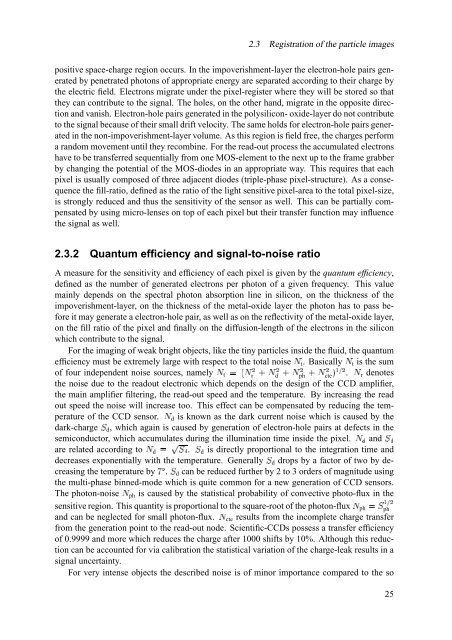The significance of coherent flow structures for the turbulent mixing ...
The significance of coherent flow structures for the turbulent mixing ...
The significance of coherent flow structures for the turbulent mixing ...
You also want an ePaper? Increase the reach of your titles
YUMPU automatically turns print PDFs into web optimized ePapers that Google loves.
2.3 Registration <strong>of</strong> <strong>the</strong> particle images<br />
positive space-charge region occurs. In <strong>the</strong> impoverishment-layer <strong>the</strong> electron-hole pairs generated<br />
by penetrated photons <strong>of</strong> appropriate energy are separated according to <strong>the</strong>ir charge by<br />
<strong>the</strong> electric field. Electrons migrate under <strong>the</strong> pixel-register where <strong>the</strong>y will be stored so that<br />
<strong>the</strong>y can contribute to <strong>the</strong> signal. <strong>The</strong> holes, on <strong>the</strong> o<strong>the</strong>r hand, migrate in <strong>the</strong> opposite direction<br />
and vanish. Electron-hole pairs generated in <strong>the</strong> polysilicon- oxide-layer do not contribute<br />
to <strong>the</strong> signal because <strong>of</strong> <strong>the</strong>ir small drift velocity. <strong>The</strong> same holds <strong>for</strong> electron-hole pairs generated<br />
in <strong>the</strong> non-impoverishment-layer volume. As this region is field free, <strong>the</strong> charges per<strong>for</strong>m<br />
a random movement until <strong>the</strong>y recombine. For <strong>the</strong> read-out process <strong>the</strong> accumulated electrons<br />
have to be transferred sequentially from one MOS-element to <strong>the</strong> next up to <strong>the</strong> frame grabber<br />
by changing <strong>the</strong> potential <strong>of</strong> <strong>the</strong> MOS-diodes in an appropriate way. This requires that each<br />
pixel is usually composed <strong>of</strong> three adjacent diodes (triple-phase pixel-structure). As a consequence<br />
<strong>the</strong> fill-ratio, defined as <strong>the</strong> ratio <strong>of</strong> <strong>the</strong> light sensitive pixel-area to <strong>the</strong> total pixel-size,<br />
is strongly reduced and thus <strong>the</strong> sensitivity <strong>of</strong> <strong>the</strong> sensor as well. This can be partially compensated<br />
by using micro-lenses on top <strong>of</strong> each pixel but <strong>the</strong>ir transfer function may influence<br />
<strong>the</strong> signal as well.<br />
2.3.2 Quantum efficiency and signal-to-noise ratio<br />
A measure <strong>for</strong> <strong>the</strong> sensitivity and efficiency <strong>of</strong> each pixel is given by <strong>the</strong> quantum efficiency,<br />
defined as <strong>the</strong> number <strong>of</strong> generated electrons per photon <strong>of</strong> a given frequency. This value<br />
mainly depends on <strong>the</strong> spectral photon absorption line in silicon, on <strong>the</strong> thickness <strong>of</strong> <strong>the</strong><br />
impoverishment-layer, on <strong>the</strong> thickness <strong>of</strong> <strong>the</strong> metal-oxide layer <strong>the</strong> photon has to pass be<strong>for</strong>e<br />
it may generate a electron-hole pair, as well as on <strong>the</strong> reflectivity <strong>of</strong> <strong>the</strong> metal-oxide layer,<br />
on <strong>the</strong> fill ratio <strong>of</strong> <strong>the</strong> pixel and finally on <strong>the</strong> diffusion-length <strong>of</strong> <strong>the</strong> electrons in <strong>the</strong> silicon<br />
which contribute to <strong>the</strong> signal.<br />
For <strong>the</strong> imaging <strong>of</strong> weak bright objects, like <strong>the</strong> tiny particles inside <strong>the</strong> fluid, <strong>the</strong> quantum<br />
efficiency must be extremely large with respect to <strong>the</strong> noiseÅ total BasicallyÅ t. t is <strong>the</strong> sum<br />
<strong>of</strong> four namelyÅ independent noise sources, r denotes<br />
<strong>the</strong> noise due to <strong>the</strong> readout electronic which depends on <strong>the</strong> design <strong>of</strong> <strong>the</strong> CCD amplifier,<br />
<strong>the</strong> main amplifier filtering, <strong>the</strong> read-out speed and <strong>the</strong> temperature. By increasing <strong>the</strong> read<br />
out speed <strong>the</strong> noise will increase too. This effect can be compensated by reducing <strong>the</strong> temperature<br />
<strong>of</strong> <strong>the</strong> CCD<br />
t£<br />
d is known as <strong>the</strong> dark current noise which is caused by <strong>the</strong><br />
dark-chargeÉd, which again is caused by generation <strong>of</strong> electron-hole pairs at defects in <strong>the</strong><br />
Å 9cteB8ÇÆÈ9.Å<br />
sensor.Å<br />
semiconductor, which accumulates during <strong>the</strong> illumination pixel.ÅËÊ time inside <strong>the</strong><br />
are toÅ related according directly proportional to <strong>the</strong> integration time d£ÎÍ andÉÌÊ<br />
ÉÌÊ.Éd is<br />
9 ry Å 9dy Å<br />
9phy >Å<br />
decreases exponentially with <strong>the</strong> temperature. GenerallyÉd drops by a factor <strong>of</strong> two by decreasing<br />
<strong>the</strong> temperature can be reduced fur<strong>the</strong>r by 2 to 3 orders <strong>of</strong> magnitude using<br />
by53.Éd<br />
<strong>the</strong> multi-phase binned-mode which is quite common <strong>for</strong> a new generation <strong>of</strong> CCD sensors.<br />
photon-noiseÅ <strong>The</strong> ph is caused by <strong>the</strong> statistical probability <strong>of</strong> convective photo-flux in <strong>the</strong><br />
sensitive region. This quantity is proportional to <strong>the</strong> square-root <strong>of</strong> photon-fluxÅ ph£<br />
<strong>the</strong><br />
and can be neglected <strong>for</strong> small photon-flux.Å cte results from <strong>the</strong> incomplete charge transfer<br />
from <strong>the</strong> generation point to <strong>the</strong> read-out node. Scientific-CCDs possess a transfer efficiency<br />
<strong>of</strong> 0.9999 and more which reduces <strong>the</strong> charge after 1000 shifts by 10%. Although this reduction<br />
can be accounted <strong>for</strong> via calibration <strong>the</strong> statistical variation <strong>of</strong> <strong>the</strong> charge-leak results in a<br />
signal uncertainty.<br />
É<br />
For very intense objects <strong>the</strong> described noise is <strong>of</strong> minor importance compared to <strong>the</strong> so<br />
ph<br />
8ÇÆÈ9<br />
25
















